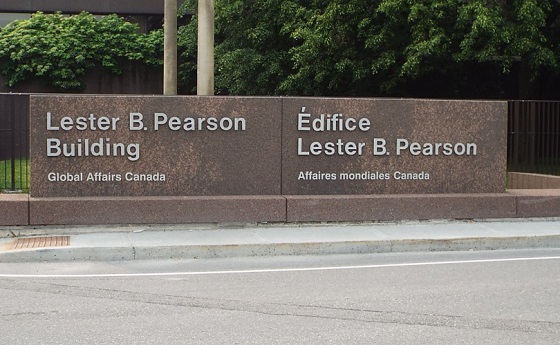Business
What an Effective All-of-Government Program Review Might Look Like

More than once in this space I’ve advocated for a comprehensive all-of-government review to find and eliminate waste and corruption. So it’s about time I set finger to keyboard and started mapping out how such a review might unfold.
Why is it just this moment in history that finds me so passionate about reviews?
Canada’s government spends more money than it receives. I know that’s hardly breaking news, but Ottawa’s reckless and frenzied race to max out every credit card in the known universe has driven the federal debt to $1.24 trillion. That’s 42.1 percent of GDP.¹
Among the biggest expenses? Employment growth in the federal civil service. Parliament employed 276,367 people in 2015 but by 2023 that had exploded to 370,368. That 94,001 increase amounts to a jump of 34 percent. For context, Canada’s overall population during that time increased by just 12 percent.
Given that the average weekly earnings for individuals employed in federal government public administration was $1,779 in 2023, just covering salaries for those extra 94,001 workers cost us $8.7 billion through that year.
But workers cost us much more than just their salaries. There are pension and CPP contributions, EI premiums, health and dental benefits, and indirect costs like office accommodations and training. All that could easily add another $50,000 per employee. Multiply that by all the new hires, and the total cost of those extra 94,001 workers has ballooned to $13.4 billion. That would be nearly a quarter of the deficit from the 2024 $61.9 billion fall update.² (Chrystia Freeland may not have been the one to officially announce that number, but she and her boss were the ones who got us there.)
Of course using a lottery to select, say, two out of every five bureaucrats for firing won’t give us the result we’re after. We want to improve government, not cripple it. (Although, to be completely honest, I find the idea of random mass firings way more attractive than I should.)
A successful review will identify programs that aren’t delivering cost-effective value to the people of Canada. Some of those programs will need changes and others should disappear altogether. For some, appropriate next-steps will come to light only through full audits.
But success will also require creating an organizational culture that earns the respect and buy-in of department insiders, stakeholders, and the general public.
The rest of this post will present some foundational principles that can make all that attainable. I should note that this post was greatly enhanced from input using the invaluable experience of a number of The Audit subscribers.
Use Transparent and Well-Defined Goals
Consensus should always be the ideal, but clarity is non-negotiable. Program advocates must be prepared to convincingly explain what they’re trying to achieve, including setting clear metrics for success and failure. Saving taxpayer funds to avoid economic catastrophe is obviously a primary goal. But more effective governance and more professional service delivery also rank pretty high.
Questions to ask and answer before, during, and after review operations:
- Does the program under review fall within the constitutional and operational scope of the federal government?
- Is there overlap with other programs or other levels of government?
- Are the original policy goals that inspired the program still relevant?
- Is the program in its current form the most effective and economical way of achieving those goals?
- Are the changes you’re proposing sustainable or will they sink back into the swamp and disappear as soon as no one’s looking?
Perhaps the most important goal of them all should be getting the job done in our lifetimes. We’ve all seen commissions, working groups, and subcommittees that drag on through multiple years and millions of dollars. You don’t want to make dumb mistakes, but that doesn’t mean you can’t adopt new tools or methodologies (like Agile) to speed things up.
Transparency is a fundamental requirement for public and institutional buy-in. That means publishing program goals and processes along with regular updates. It also means being responsive to reasonable requests for information. Fortunately, someone (Al Gore?) invented the internet, so it should be possible to throw together an interactive browser-based dashboard that keeps the rest of us in the loop and allows for feedback.
Over the years, I’ve personally built nice(ish) websites in minutes, even sites that use pipelines for dynamically pulling data from third-party sources. This isn’t rocket science – especially when you’re not dealing with sensitive private data.
Be Non-Partisan
Going to war against the complexity, toxic politics, incompetence, institutional inertia, NIMBY-ism, and sheer scope of government waste is not for the faint of heart. But setting yourself up as the Righteous Redeemer of only 40 percent of Canadians will make things infinitely more difficult.
Key project positions have to be filled by the most capable individuals from anywhere on the political spectrum. And proposals for cuts should rise above political gamesmanship. It may be unreasonable to expect friendly cross-the-aisle collaboration, but the value of the eventual results should be so self-evident that they’re impossible to oppose in good faith.
Frankly, if you’d ask me, any government that managed to miraculously rise above partisan silliness and genuinely put the country’s needs first would probably guarantee itself reelection for a generation.
Be Efficient
Don’t reinvent the wheel. If internal or external departmental audits already exist, then incorporate their findings. Similarly, make use of any existing best-practice policies, standards, and guidance from bodies like the Office of the Comptroller General and the Treasury Board of Canada Secretariat.
It’ll be important to know who really controls the levers of power within government. So make sure you’ve got members of key insider organizations like the Privy Council Office and the Committee of Senior Officials on speed dial.
Also, incorporate forward-thinking elements into new programs by including sunset clauses, real-time monitoring, and ongoing mini reviews. To keep things moving fast, implement promising auditing and analysis ideas early as pilot programs. If they work, great. Expand. If they don’t work, bury ‘em. No harm done.
AI-driven insights can probably speed up early steps of the review process. For instance, before you even book your first meeting with the dreaded Assistant Deputy Minister, feed the department’s program spending and outcomes data to an AI model and tell it to look for evidence-based inefficiencies and redundancy. The results can set the agenda for the conversation you eventually do have.
You can similarly build simple software models that search for optimal spending balances across the whole government. Complex multivariate calculations that once required weeks of hard math can now be done in seconds.
A friend who administrates a private high school recently tasked ChatGPT with calculating the optimal teaching calendar for the coming school year. After a few seconds, the perfect schedule showed up on-screen. The woman who, in previous years, had spent countless hours on the task, literally laughed with excitement. “What are you so happy about?” My friend asked. “This thing just took your job.”
Consult the Civil Service (and the public)
I know exactly what you’re thinking: is there a better way to destroy any process than burying it under endless rounds of public consultations (followed by years of report writing)? Trust me, I feel your pain.
But it’s 2025. Things can be different now. In fact, contrary to the way it might look to many good people inside the public sector, things can be a lot better.
This consultation would be 100 percent digital and its main stage need last no longer than 60 days. Here’s how it’ll go:
- Build a website, make a lot of noise to attract attention, and invite all Canadians – with a particular focus on current and former civil servants.
- Require login that includes a physical address and (perhaps) a government-issued ID. This will prevent interest groups from gaming the system.
- Use AI tools to identify boilerplate cut-and-paste submissions and flag them for reduced relevance.
- Encourage (but don’t require) participants to identify themselves by their background and employment to permit useful data segmentation. This will make it easier to identify expert submissions.
- Provide ongoing full public access to all submissions. Private information would be redacted, of course. And whistle blowers could have specialized, extra-secure access.
- Use traditional software analytics to flag especially interesting submissions and analyze all submissions using AI models to produce deeper summaries and analyses.
- Publish ongoing overviews of the results.
- [Other stuff…]
- Pick out a nice suit/dress for your Order of Canada investiture ceremony.
There’s absolutely nothing revolutionary about any of this (except the Order of Canada bit). The City of Toronto has been doing most of it for years.
Subscribe to The Audit.
For the full experience, upgrade your subscription.
Business
Liberals refuse to disclose the amount of taxpayer dollars headed to LGBT projects in foreign countries

From LifeSiteNews
The Liberal government of Prime Minister Mark Carney will not openly disclose how much money from its foreign-aid budget is going toward overseas “gender identity” and “decolonization” projects.
According to the government, there are “concerns” that disclosing the amount of funds could endanger certain LGBT organizations that get money from it.
On November 3, Global Affairs Canada, in response to a question on the order paper from a Conservative MP, said that the funding amounts could not be made public due to claimed “security concerns” and “confidentiality requirements.”
“These are the most common reasons projects are considered sensitive: the organization or individuals might be in danger if it becomes known that they are receiving funds from a foreign government; (or) implementing a project related to sensitive topics such as two-spirit, lesbian, gay, bisexual, transgender, queer, intersex and additional sexually and gender-diverse people rights, human trafficking, early/forced marriage, (and) human rights defenders,” Global Affairs noted.
Continuing, Global Affairs said that there is a possible “danger” to partner organizations that could be “forced to close” or even “arrested” due to “harassment from the local population or government.”
As reported by LifeSiteNews, Carney’s budget will include millions in taxpayer money for “SLGBTQI+ communities,” gender equality, and “pride” safety.
Canada’s 2025 federal budget is allotting some $54.6 million to LGBT groups in a move criticized by Campaign Life Coalition as prioritizing activist agendas over struggling families’ basic needs.
Canadian taxpayers are already dealing with high inflation and high taxes due in part to the Liberal government overspending and excessive money printing, and even admitting that giving money to Ukraine comes at the “taxpayers’” expense.
As recently reported by LifeSiteNews, Bank of Canada Governor Tiff Macklem gave a grim assessment of the state of the economy, essentially telling Canadians that they should accept a “lower” standard of living.
Business
Carney’s Floor-Crossing Campaign. A Media-Staged Bid for Majority Rule That Erodes Democracy While Beijing Hovers

In a majority government, an unprecedented and risky, course-altering national policy — deepening ties with Beijing while loosening ties with Washington — is considerably easier to execute.
On budget day, Ottawa’s reporters were sequestered in the traditional lock-up, combing through hundreds of pages, when Politico detonated a perfectly timed scoop: Conservative MP Chris d’Entremont was weighing a jump to Mark Carney’s Liberals. Within hours, he crossed, moving the government to within two seats of a majority — one that would guarantee Carney’s hold on power until 2029 — without Canadians casting a single ballot.
This was no ordinary budget day. By orchestrating a floor-crossing during a media lock-up, the Liberals blurred scrutiny of a historic spending plan while inching toward a de facto majority. That sequence raises deeper concerns about media–political entanglements and the democratic legitimacy of building a majority outside the polls.
Toronto Sun columnist Brian Lilley, in a deeply reported Substack post yesterday, captured months of palace intrigue. A well-sourced politics reporter with lines into Conservatives and Liberals alike, he lays out the knowns, the known unknowns, and the plausible backroom plays. Carney’s courting began right after the April 28 election that left him sitting at 169 seats, Lilley writes. For weeks, the Liberals probed for weak ribs in the Conservative caucus; and on November 4, they landed one.
“One thing is clear, the Liberals have been trying to poach a lot of Conservative MPs and doing everything they can to convince them to cross the floor,” he concluded.
Why? According to Lilley, Carney has been “governing for the most part like he has a majority, and he clearly doesn’t want to engage in the horse trading that a minority Parliament requires, so poaching MPs can solve his problem.”
The fallout was already clear to see last week. And it doesn’t look good for Canadian democracy or Canadian media, which receives significant government subsidies. Even at surface level, the press corps was visibly distracted from its first duty to citizens: scrutinizing a historically large budget packed with nation-building promises and unanswered questions about feasibility. Veteran reporters have already acknowledged this.
In another piece this weekend, Catherine Tunney, a solid CBC reporter, explained how Pierre Poilievre was undermined this way: “For the Opposition, budget week is a communications gift. It’s an easy way for the party to call out government spending,” she wrote. “For a leader who has built his brand on calling out Liberal spending, tabling a budget with a $78-billion deficit is the political equivalent of pitching a strike straight down the middle to Dodger slugger Shohei Ohtani.”
But instead, “of taking a victory lap around the bases, [Poilievre] ended the week facing questions about his leadership — after losing one MP to his rivals and another resigning from federal politics altogether.”
The messaging continued yesterday, with another CBC report amplifying the Liberals’ narrative that Conservative leaders were actively bullying MPs not to cross.
CBC had to issue a correction. After publishing d’Entremont’s account that senior Conservatives “pushed” his assistant, CBC later updated the story to clarify that Andrew Scheer and Chris Warkentin “pushed open the door,” and the aide stepped aside — a meaningful distinction.
Stepping back from the noise, there is a deeper problem.
Making honeyed promises to floor-crossers is legal in Canada’s democracy. But Canada is in a mounting trade war involving China and the United States, in an increasingly dangerous, cutthroat geopolitical environment. Already, the prime minister is pledging renewed engagement with Beijing as a strategic partner.
Doing so in a minority Parliament means facing tough accountability questions — and bruising inquiries in ethics committee hearings. In a majority government, an unprecedented and risky, course-altering national policy — deepening ties with Beijing while loosening ties with Washington — is considerably easier to execute.
And what kind of partner is Carney choosing? Yesterday, Japan lodged formal complaints after a senior Chinese diplomat took to social media and threatened to “cut [the] dirty neck” of Japan’s new leader over her stance on Taiwan. On Friday, Prime Minister Sanae Takaichi had said a Chinese attack on Taiwan could constitute “a survival-threatening situation” for Japan, potentially requiring the use of force.
“We have no choice but cut off that dirty neck that has been lunged at us without hesitation. Are you ready?” Chinese Consul General Xue Jian said in a message posted on X, which was later deleted.
This is the government Carney is rapidly sliding closer to. The same regime that jailed Canadians Michael Kovrig and Michael Spavor in the Meng Wanzhou affair — and a government that, Canadian intelligence has warned, attempts to shape media narratives in Canada.
As The Bureau reported in 2023, Canada’s own Privy Council Office warned in a January 2022 Special Report that Beijing’s United Front Work Department targets Canadian institutions.
In a section alleging Beijing “manipulates traditional media” in Canada, the report details press conferences held in January 2019 by former Toronto-area Liberal cabinet minister John McCallum, to argue that Canada’s detention of Huawei executive Meng Wanzhou was illegal. McCallum, then ambassador to China, was forced to resign after the Conservative opposition condemned his comments.
In the fallout, according to the Privy Council Office report, Canadian intelligence uncovered that several Chinese diplomats in Canada were voicing support for McCallum. One Chinese consulate official “sent information” to an unidentified Canadian media reporter indicating Chinese Canadians have favourable impressions of McCallum, the report says.
Now back to Ottawa media’s role. Why and how did Politico get the floor-crossing scoop during the budget lock-up — and then, that same evening, co-host a post-budget reception branded “Prudence & Prosecco” at the Métropolitain Brasserie, where Finance Minister François-Philippe Champagne and well-placed Liberals mingled with reporters? Every veteran reporter knows political parties try to influence the press — they’re called spin doctors for a reason. But darker forces can ride the same channels. In Brussels, for example, European security services are investigating a former Politico reporter over alleged ties to Chinese intelligence — still unproven, but a cautionary tale about the murkiness of media–political ecosystems.
Lilley also documents how coverage of another rumoured floor-crosser, Matt Jeneroux, became part of last week’s fog machine. The Toronto Star reported a private meeting between Jeneroux and Carney involving senior Liberal strategists Braden Caley and Tom Pitfield; Jeneroux issued categorical denials to senior Conservatives. “Someone is lying,” Lilley writes — and whether or not a second crossing was imminent, the destabilization served its purpose. Other names floated, such as Michael Chong, were so implausible as to raise suspicion of calculated disinformation.
“I didn’t buy Chong either, but Liberals kept pushing that narrative,” Lilley wrote. “As someone who knows Michael a bit, I simply didn’t believe it, didn’t even reach out to ask — he later called me to confirm the rumours were bogus.”
It is geopolitically notable that Michael Chong — sanctioned by Beijing and repeatedly targeted in PRC pressure campaigns, including a Chinese intelligence operation targeting Chong and his family that Justin Trudeau’s government failed to notify him about — saw his name tossed into this mess. Who benefits from saddling Chong with corrosive rumours?
It would seem that not only the Liberals benefit, but so do Carney’s new “strategic partners” in Beijing. None of this proves any newsroom has wittingly acted in bad faith, nor is there any evidence that Beijing’s shadow looms in the Liberals’ media playbook. But it does suggest how a coordinated political operation can be abetted by domestic media distraction.
Now, consider darker possibilities that could be in play. Not necessarily last week, but in any number of major events and stories shaping relations among Canada, China, and the United States.
The bipartisan NSICOP 2024 Review into allegations of Chinese election interference in Canada’s last two federal elections found that “during the period under review, the intelligence community observed states manipulating traditional media to disseminate propaganda in what otherwise appeared to be independent news publications.”
It added: “Foreign states also spread disinformation to promote their agendas and consequently challenge Canadian interests, which posed the greatest cyber-threat activity to voters during the time under review.”
The report continued: “These tactics attempt to influence public discourse and policymakers’ choices, compromise the reputations of politicians, delegitimize democracy, or exacerbate existing frictions in society.”
According to the intelligence community, “the PRC was the most capable actor in this context, interfering with Canadian media content via direct engagement with Canadian media executives and journalists.”
So what do we have here? Carney’s Liberals have a natural interest in destabilizing the Conservatives and sending Pierre Poilievre — a prosecutorial-style politician who excels at exposing his opponents’ weaknesses — into early political retirement. Arguably, they have a well-founded interest in dividing the Conservative Party itself.
But using the media to float names of opposition MPs who never intended to cross is disinformation, plain and simple. And when that name is Michael Chong — long targeted by Beijing — the stakes rise. If Carney is tilting toward a “strategic partnership” with Beijing, and if that delays the Foreign Influence Transparency Registry, as critics such as Dr. Charles Burton warn, then the tactics on display have moved from questionable to unacceptable — and risk entangling the interests of the Liberal Party of Canada with those of the Chinese Communist Party in Beijing.
The Bureau is a reader-supported publication. To receive new posts and support my work, consider becoming a free or paid subscriber.
-

 Agriculture15 hours ago
Agriculture15 hours agoBovaer Backlash Update: Danish Farmers Get Green Light to Opt Out as UK Arla Trial Abruptly Ends!
-

 Business2 days ago
Business2 days agoCBC cashes in on Carney as the news industry playing field tilts further in its favour, crippling the competition
-

 Business20 hours ago
Business20 hours agoCarney’s Floor-Crossing Campaign. A Media-Staged Bid for Majority Rule That Erodes Democracy While Beijing Hovers
-

 Daily Caller1 day ago
Daily Caller1 day agoMcKinsey outlook for 2025 sharply adjusts prior projections, predicting fossil fuels will dominate well after 2050
-

 Agriculture1 day ago
Agriculture1 day agoFarmers Take The Hit While Biofuel Companies Cash In
-

 Business1 day ago
Business1 day agoTrump: Americans to receive $2,000 each from tariff revenue
-

 armed forces16 hours ago
armed forces16 hours agoIt’s time for Canada to remember, the heroes of Kapyong
-

 International1 day ago
International1 day agoBBC boss quits amid scandal over edited Trump footage





